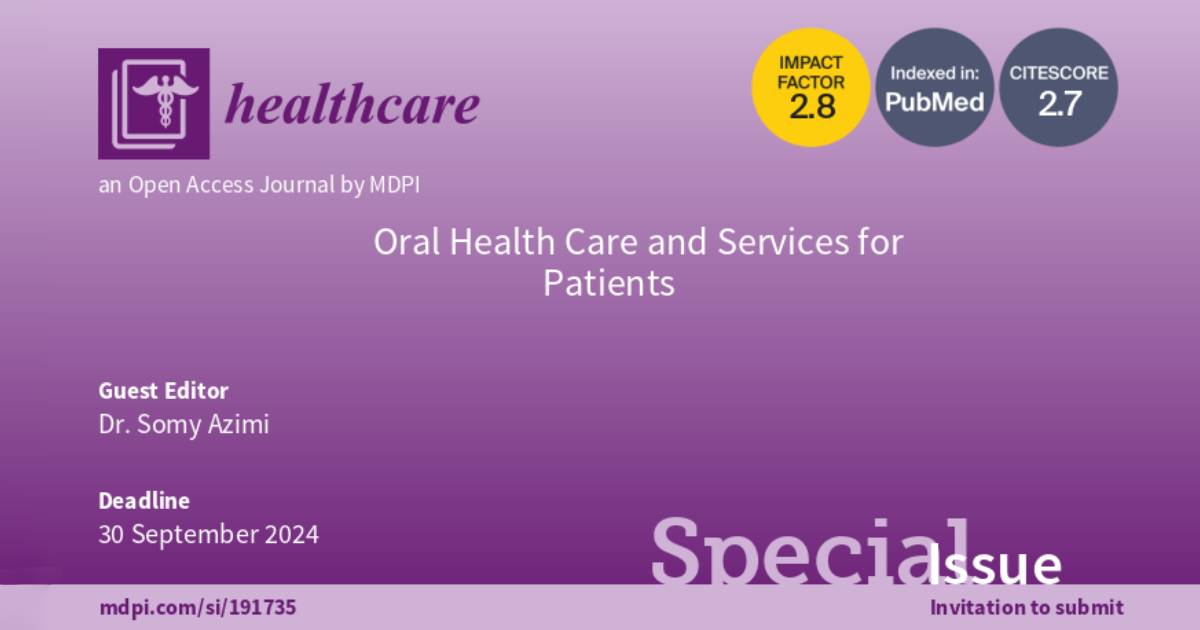Oral Health Care and Services for Patients
A special issue of Healthcare (ISSN 2227-9032). This special issue belongs to the section "Nursing".
Deadline for manuscript submissions: 31 March 2026 | Viewed by 8952

Special Issue Editor
Special Issue Information
Dear Colleagues,
I am pleased to extend an invitation to you to contribute to our upcoming Special Issue entitled “Oral Health Care and Services for Patients”.
Oral health is an essential component of overall health and well-being. However, many people face various challenges and barriers in accessing oral health care and services, such as a lack of affordability, availability, accessibility, acceptability, and awareness. These challenges can result in oral health disparities and inequalities among diverse population groups, such as the elderly, children, people with disabilities, individuals living in rural or remote areas, and those from low-income or culturally and linguistically diverse backgrounds.
The objective of this Special Issue is to provide a platform for practitioners, researchers, policymakers, and stakeholders to share their latest findings, experiences, and perspectives on oral health care and services for patients. We invite diverse contributions focusing on key areas in oral health. Submissions may explore oral health status and determinants among different patient groups, alongside advancements in diagnostic tools and treatment. We are interested in discussions around oral health care delivery models, systems, and policies, emphasizing quality, safety, and outcomes. We also encourage insights into the dynamics of oral health care access and utilization, and the evolving landscape of innovation, technology, and digitalization in oral health care.
We look forward to receiving your valuable contributions to this Special Issue, highlighting challenges, opportunities, and future directions in the multifaceted field of oral health.
Dr. Somy Azimi
Guest Editor
Manuscript Submission Information
Manuscripts should be submitted online at www.mdpi.com by registering and logging in to this website. Once you are registered, click here to go to the submission form. Manuscripts can be submitted until the deadline. All submissions that pass pre-check are peer-reviewed. Accepted papers will be published continuously in the journal (as soon as accepted) and will be listed together on the special issue website. Research articles, review articles as well as short communications are invited. For planned papers, a title and short abstract (about 100 words) can be sent to the Editorial Office for announcement on this website.
Submitted manuscripts should not have been published previously, nor be under consideration for publication elsewhere (except conference proceedings papers). All manuscripts are thoroughly refereed through a single-blind peer-review process. A guide for authors and other relevant information for submission of manuscripts is available on the Instructions for Authors page. Healthcare is an international peer-reviewed open access semimonthly journal published by MDPI.
Please visit the Instructions for Authors page before submitting a manuscript. The Article Processing Charge (APC) for publication in this open access journal is 2700 CHF (Swiss Francs). Submitted papers should be well formatted and use good English. Authors may use MDPI's English editing service prior to publication or during author revisions.
Keywords
- patient-centric care
- preventive dentistry
- technology and telehealth in dentistry
- patient education
- public health dentistry
- interdisciplinary approaches
Benefits of Publishing in a Special Issue
- Ease of navigation: Grouping papers by topic helps scholars navigate broad scope journals more efficiently.
- Greater discoverability: Special Issues support the reach and impact of scientific research. Articles in Special Issues are more discoverable and cited more frequently.
- Expansion of research network: Special Issues facilitate connections among authors, fostering scientific collaborations.
- External promotion: Articles in Special Issues are often promoted through the journal's social media, increasing their visibility.
- e-Book format: Special Issues with more than 10 articles can be published as dedicated e-books, ensuring wide and rapid dissemination.
Further information on MDPI's Special Issue policies can be found here.






